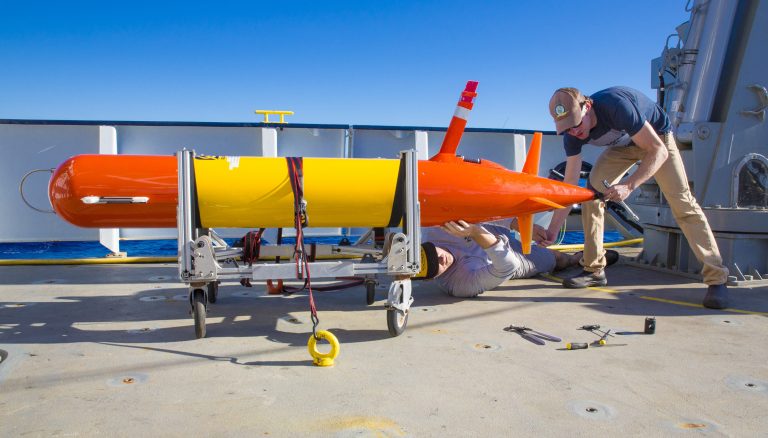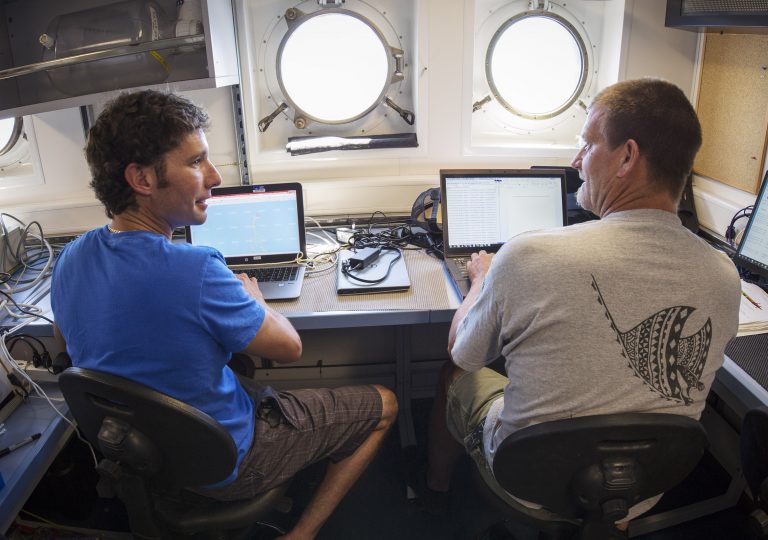The ocean is full of relatively small events that happen over a short period of time. To help scientists maintain a more persistent observing presence in the ocean, we use robots called Autonomous Underwater Vehicles (AUVs) to move around the ocean in three dimensions and collect data.
On this research cruise we are using 3 different types of autonomous robots all working together to get a better snapshot of what is happening in an eddy north of Moloka‘i. These vehicles help us to see the dynamic and 3-D ecosystem of the ocean, even though it looks flat (on a nice day) and unchanging at the surface.
Onboard the Research Vessel Falkor, while scientists are busy preparing their lab spaces with bottles and reagents, the long range AUV team is getting ready in a different way: installing drop weights, configuring sensors, and making sure the software is all in order. It is a busy time for everyone, and it plays out differently for each team, but that is the spirit of collaboration!

When the science gets started again on Leg 2 of this cruise, the scientists will gather samples from the CTD Rosette, filter water in the wet lab, or set up experiments in incubators on the top deck. The LRAUV team will instead be immersed in a world of a computer screens. Data from the vehicles trickles back to the Science Control room on the Falkor via cell phone and satellite connection, giving us some clues about the state of our vehicles. Is the vehicle flying smoothly through the water and behaving the way we expect? Are the CTD sensors are working properly? Periodic GPS updates let us know if all the assets are headed where we intended. These updates are collectively plotted on a satellite map of the eddy system enabling us to make sure all the vehicles are on the right track (real-time tracking website). In addition, data on health of the vehicle (such as battery charge) lets us know if the mission can complete successfully or if we need to change something. All of these data – and the questions that arise – constantly play across our computer screens and in our minds.

Sometimes we communicate with each other while in the same room. Sometimes over instant messaging thousands of miles apart. Collectively, we all have a mental picture of how the experiment is going, where each vehicle is, and its health status. Sometimes these robots seem perfectly happy on their own, and other times it takes all of us to keep the operation on track, sifting through endless streams of sensor data, mission updates, and GPS locations sent from robots to the ship over satellite. We are always standing by to figure out if something has gone wrong, and what we can do to fix it.

The constellation of #MicrobeEddyBots moving through the ocean, synchronized by a collective mission. Mola, the wave glider at the surface, continually tracks Aku, which is following the deep chlorophyll maximum (DCM) ~100m below the surface taking samples every 3 hours. Opah also tracks Aku in a spiraling pattern collecting additional data above and below the DCM.Visualization: Thom Hoffman
In addition to cruises like our month on the Falkor, the MBARI team has run autonomous vehicles nearly 300 days per year, which is much more time at sea than most ships can operate. Multiple vehicles (and pilots) are required to support this level of operations. Thankfully, the current vehicles are designed to be relatively reliable as autonomous robots, meaning they can make decisions on their own, inside their mission parameters. That autonomy allows us (their pilots) to go home, have dinner, and play with our kids.
Sometimes, however, we find ourselves in strange situations… A vehicle, halfway around the planet, suddenly sends a text message. It is notifying their pilot something is amiss and they need help. These little robot messages can be quite a jolt, especially when you are enjoying a more personal reality, like sleeping or watching your kid’s baseball game. The continual process of reconciling your reality on land with the vehicles’ reality offshore is interesting and sometimes surreal: a little constellation of robots, swirling around in the sea and always on our minds, occasionally texts us – asking for little help from the humans.


